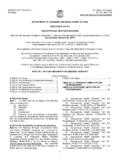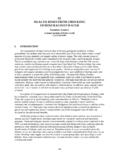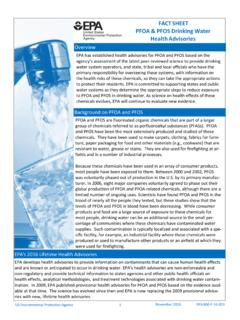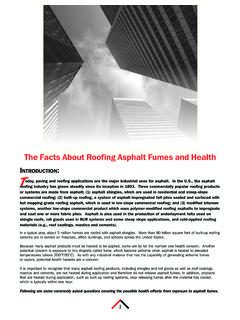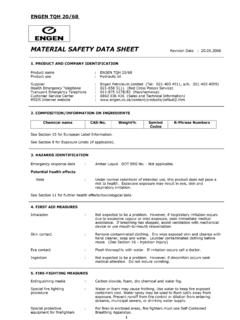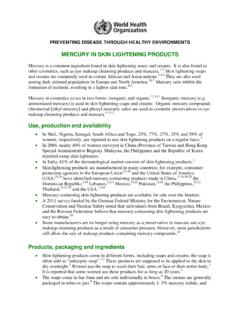Transcription of March 2015 EMA on Limits for Shared …
1 March 2015. EMA on Limits for Shared Facilities Part 1. This is the first in series of Cleaning Memos discussing the finalized version of EMA's Guideline on setting health based exposure Limits for use in risk identification in the manufacture of different medicinal products in Shared facilities . It was adopted by the Committee for Medicinal Products for Human Use (CHMP) on November 20, 2014. There is both good news and not so good news in the finalized document. Some of us may think that the document may not apply to them because they may be manufacturing in Shared facilities, but the equipment is dedicated to certain products. While it is true that the health-based Limits may be focused on product-contact surfaces as part of cleaning process validation, it is also true that the health- based Limits apply to all sources of cross-contamination, which includes product contact surfaces; but, other sources such as operator error and airborne cross-contamination may also be relevant.
2 That is (I assume) one reason that the document stops at the PDE determination and does not go on to subsequent carryover calculations typically used in cleaning validation. Also, an initial note that for terminology, the health-based limit is not necessarily just based on a PDE. The EMA document seems to call the more general limit the safe threshold value . It then states that the threshold value could be determined by a PDE formula, by the TTC (thresholds of toxicological concern) concept, or by other means if adequately justified . Basically the EMA document presents the calculation of the PDE (Permitted Daily Exposure) as previously given in the draft version (December 2012) with some minor modifications. However, it does make some changes in peripheral areas to be discussed in this Cleaning Memo or subsequent ones; an example of one of these changes is Limits for biotechnology manufacture. The PDE is to be calculated using the formula given in ICH Q3C (R4).
3 However, whereas Q3C bases the calculation on a NOEL (No Observed Effect Level), as in the draft version of the EMA document, in the finalized version it is based on the NOAEL, or No Observed Adverse Effect Level. In this way, the EMA. document is made consistent with Risk-MaPP. The reason for the change is not explicitly given, but I believe the reason is that the PDE calculation as given in this document is ordinarily used for animal studies where what I call highly hazardous properties are typically evaluated. In other words, if one is concerned about reproductive hazards or mutagenicity, one does animal studies or, in the case of the Ames test, an in vitro test (and not human clinical trials). In these tests a level that is not adverse in terms of the property being evaluated is the basis for the PDE for that critical effect. The NOAEL is then generally decreased by certain factor (intraspecies, interspecies, etc.) to derive a PDE. Note that by using a NOAEL rather than the NOEL, the EMA and Risk-MaPP are using the same basis for determining the safe level.
4 It still should be noted that the presentations of the calculations in the two documents are somewhat different, although I believe they are both addressing the same concerns. However, EMA in using the Q3C formulation appears to be much more specific in setting guidelines for various modifying factors (which might help in consistency of PDE values by different toxicologists). Copyright 2015 by Cleaning Validation Technologies. This copyright protected Cleaning Memo may be Page 1 of 3. printed for research, compliance and scientific purposes. Any other use, including downloading of the file and including commercial distribution, is illegal and unethical. Even though the EMA continues not to make reference to the ISPE Risk-MaPP document, the EMA does state in a footnote that PDE and ADE are effectively synonymous. I'm not sure why the EMA did not more formally acknowledge ISPE's Risk-MaPP. My speculation is that has something to do with EMA being more of a regulatory body and ISPE being more of an industry group, or EMA being a European group and ISPE.
5 Having much more of a North American focus (although obviously it is an international group). You might think that for certain drugs, where the primary critical effect is the therapeutic activity, that the Q3C formulation would be used. Not so! Section is titled Use of clinical data . In that section, the EMA. writes: If the most critical effect identified to determine a health-based exposure limit is based on pharmacological and/or toxicological effects observed in humans rather than animals, the use of the PDE formula may be inappropriate and a substance-specific assessment of clinical data may be used for this purpose. [Emphasis added]. I think one thing this is saying is that if the most critical effect is based on the therapeutic effect, then an evaluation of clinical data to determine a safe level is appropriate (presumably we can still call that safe level determined by this method a PDE, and don't necessarily have to restrict the PDE terminology to values only calculated by the Q3C equation).
6 It might also be likely that industry just determines a value based on clinical data and calls it a safe threshold value (STV). Part of the issue here is that it may not be likely that clinical data is available to show a NOAEL (assuming the adverse effect considered is the therapeutic effect). I say this because most companies do clinical studies to either demonstrate clinical efficacy or to demonstrate safety when administered at levels expected to be effective. The only cases where it is likely that a no therapeutic effect level is determined is for drugs that never made it out of clinical trials because of lack of efficacy. Now the EMA in Section 2 also states that a NOAEL based on clinical pharmacodynamic effects should correspond to the highest dose tested which is considered therapeutically inefficacious . It is not entirely clear what is meant by therapeutically inefficacious. Some might suggest that this means a level at which no therapeutic effect is observed.
7 That is, if the therapeutic effect is to lower blood pressure, then the highest clinical level at which no change (within experimental error) is observed is the NOAEL. Others might argue that a measured, but significant lowering of blood pressure would not be therapeutically efficacious because no one would use that dose for a therapeutic effect. It is unclear where regulators or industry would come down on this issue, but my preference would be for a clinical effect that at which the critical effect is not seen at all. Otherwise the LOAEL value may be considerably above the NOAEL value. If a NOAEL can not be established for the most critical effect based on human clinical data, it may be possible to use the Q3C calculation based on the additional adjustment factor that EMA suggests for cases where there is a LOAEL, but not a NOAEL. Note that if the data is based on relevant human clinical data, the factor dealing with interspecies variation is not relevant.
8 However, some of the other factors may certainly be applied. The EMA also changed their approach for biotechnology manufacture. Section on biotechnology products is in part as follows: Copyright 2015 by Cleaning Validation Technologies. This copyright protected Cleaning Memo may be Page 2 of 3. printed for research, compliance and scientific purposes. Any other use, including downloading of the file and including commercial distribution, is illegal and unethical. Therapeutic macromolecules and peptides are known to degrade and denature when exposed to pH. extremes and/or heat, and may become pharmacologically inactive. The cleaning of biopharmaceutical manufacturing equipment is typically performed under conditions which expose equipment surfaces to pH extremes and/or heat, which would lead to the degradation and inactivation of protein-based products. In view of this, the determination of health based exposure Limits using PDE Limits of the active and intact product may not be required.
9 [Emphasis added]. Note in this paragraph is a statement that in most situations, the biotechnology active is degraded and inactivated by the cleaning process. In view of that degradation and inactivation, health-based Limits based on PDE's may not be applicable. While not clearly stated, my guess is that the EMA still expects health-based Limits for cleaning to be determined, but the determination will be by other means. Those other means could include a toxicological evaluation of the degradation products or applying a PDE based calculation to the intact protein assuming that would be a worst case as compared to the degraded fragments. There will be more to discuss next month. However, before closing it is important to point out the dates for implementation of this guideline. Here are the statements from the EMA document on the phased in . approach: For medicinal products introduced for the first time into Shared manufacturing facilities: 6 months from publication of this guideline.
10 For medicinal products already produced in Shared manufacturing facilities the guidance will take effect, or existing arrangements should be scientifically justified, within: 1 year after publication of the guideline for manufacturers of products for human use including those who manufacture human and veterinary medicines using Shared manufacturing facilities. 2 years after publication of the guideline for manufacturers solely producing products for veterinary use.. If publication means November 20, 2014, these times for implementation seem extremely unrealistic and aggressive (my opinion), particularly in light of the significant changes between the draft document and this final version. We'll have to wait and see how this will be enforced by the EMA. Copyright 2015 by Cleaning Validation Technologies. This copyright protected Cleaning Memo may be Page 3 of 3. printed for research, compliance and scientific purposes. Any other use, including downloading of the file and including commercial distribution, is illegal and unethical.

